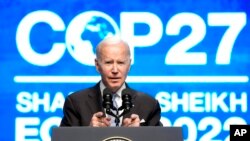“According to the World Meteorological Organization, the past eight years have been the warmest on record,” said President Joe Biden at the 2022 United Nations Climate Change Conference, or COP27, in Sharm El-Sheikh, Egypt. “Over the past two years, the United States has delivered unprecedented progress at home… I can stand here as President of the United States of America and say with confidence: The United States of America will meet our emissions targets by 2030.”
However, the climate crisis is hitting hardest those countries and communities that have the fewest resources to respond and to recover. In most cases, they are also the countries that have contributed the least to the problem. That’s why President Biden committed to providing 11 billion dollars annually to support climate finance, including 3 billion for adaptation. The fund, called the President’s Emergency Plan for Adaptation and Resilience, or PREPARE, will help more than half a billion people in developing countries respond to climate change.
“As a down payment, we’re announcing more than $150 million in initiatives that specifically support PREPARE’s adaptation efforts throughout Africa, including the Adaptation in Africa effort that Egypt and the United States launched together in June.”
Among other programs, the United States supports the Global Shield, a G7 initiative meant to protect vulnerable countries from climate-related losses and respond to climate-related damages.
Another G-7 program, Partnership for Global Infrastructure and Investment, intends to meet critical infrastructure needs in low- and middle-income countries, with an eye toward climate.
A partnership between U.S. firms and the government of Angola that has invested 2 billion dollars in new solar projects in Angola is already under way.
Then there is the Global Methane Pledge, meant to mitigate methane emissions, which was initiated last year by President Biden and European Commission President Von der Leyen.
“More than 130 countries have signed on to covering more than half of the global methane emissions. Methane is 80 times more potent than carbon, and it accounts for nearly half — half of the net warming we’re experiencing now. So cutting methane by at least 30 percent by 2030 can be our best chance to keep within reach of 1.5 degrees Celsius target.”
“Everyone has to keep accelerating our efforts throughout this decisive decade,” said President Biden. “The challenges we face are great, but our capacity is greater than the challenges. We must never doubt that.”














